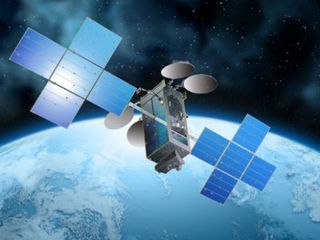New Hughes/EchoStar Satellite to Deliver 100 Mbps-Plus

Hughes Network Systems, a unit of EchoStar, said this week it’s eyeing broadband speeds of 100 Mbps and more via new high-density satellite that’s expected to launch in early 2021.
Hughes, which ended Q2 with 1,085,000 satellite broadband subs, has tapped Space Systems Loral to build the next-gen Jupiter 3 bird, which will be designated “EchoStar XXIV.”
The new satellite will target “key markets” across the Americas, including the U.S., Canada, Mexico, Brazil and other countries in South America, and will more than double the Hughes Ka-band capacity in the region, the company said.
Plans for the new satellite come more than two months after ViaSat launched ViaSat2, a high-powered satellite with 300 Gbps of total throughput that will also eye service tiers of 100 Mbps and more. ViaSat 2 is expected to enter into service in early 2018, with services slated to get underway in Q4 of the company’s fiscal 2018.
RELATED: ViaSat 2 Launches With Big Broadband Potential
Hughes launched its HughesNet Gen5 service in March and has been upgrading subs to the speedier platform, which matches a 25 Mbps downstream with a 3 Mbps upstream and is powered by EchoStar XIX/Jupiter 2, a multi-spot-beam, Ka-band satellite made by Space Systems Loral that launched in December 2016.
Though Hughes has largely focused on rural areas, it’s seeing opportunities where DSL service is weak, Peter Gulla, Hughes’s SVP of marketing, told Multichannel News in a recent interview.
Multichannel Newsletter
The smarter way to stay on top of the multichannel video marketplace. Sign up below.
RELATED: Looking For Powerful Liftoff (subscription required)
“Right now, 25 [Mbps] seems to be meeting the needs of our customers,” he said at the time. “But that doesn’t mean that’s the end of the line.”
The appeal of satellite broadband services have been limited somewhat by restrictive data caps and latency issues that impair interactive services such as VoIP and multiplayer gaming. In some instances, satellite broadband players are also expected to see more competition from speedier LTE and next-gen 5G-based fixed wireless data offerings.
Hughes president Pradman Kaul downplayed the severity of the 5G threat on EchoStar’s Q2 call.
“The problem is that the amount of bandwidth available at that spectrum is… in smaller pieces of bandwidth,” he said, according to Space Intel Report. They won’t be competing with us directly because we’re going up to 100 megabits per second. In the low end of the spectrum that 5G will be using, that’s not a competitor. Then you go into the millimeter-wave spectrum, the 28-, 30-, 37-GHz pieces. There, the cell sizes are very small, but they will be focused in the urban areas, where we don’t compete.”
ViaSat ended its fiscal Q1 with 625,000 residential broadband subscribers. The company attribute that loss, of about 34,000 subs, to a mix of seasonality, Hughes’s new Jupiter 2 satellite as well as unlimited mobile wireless services.
